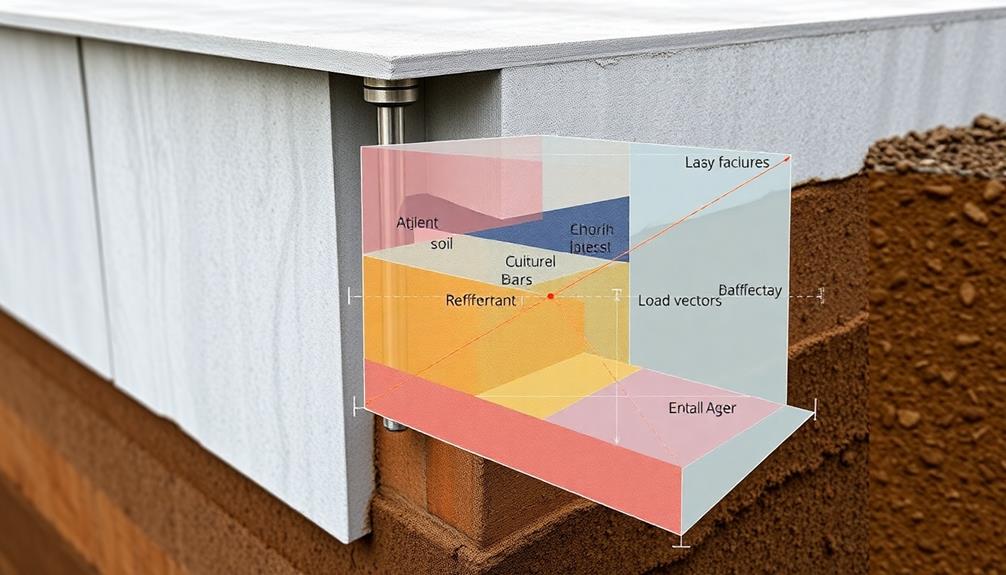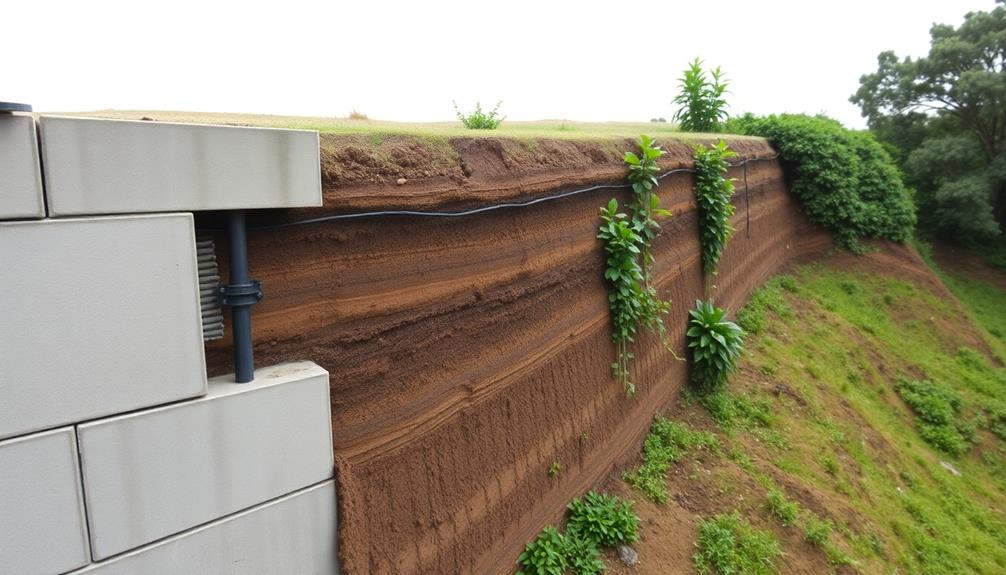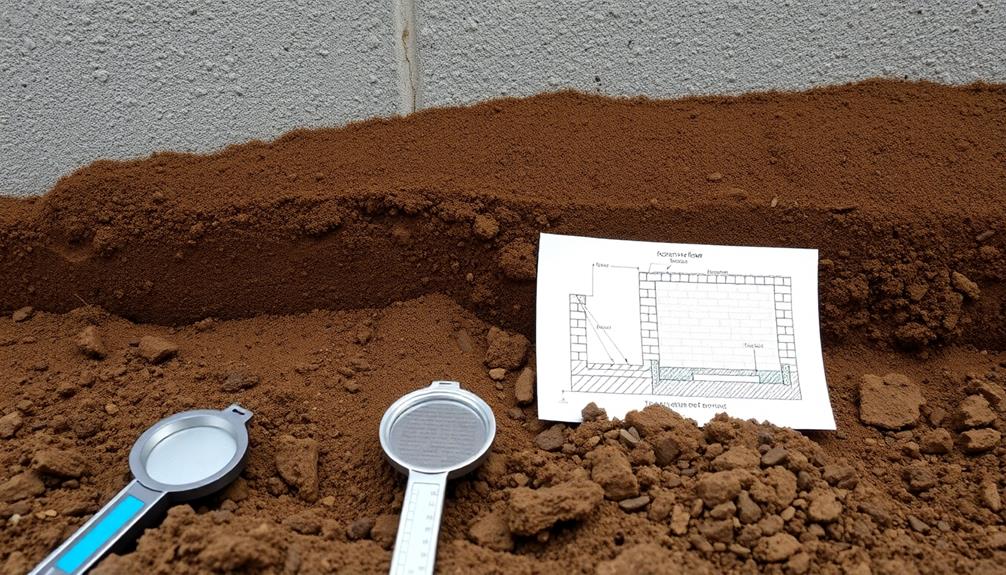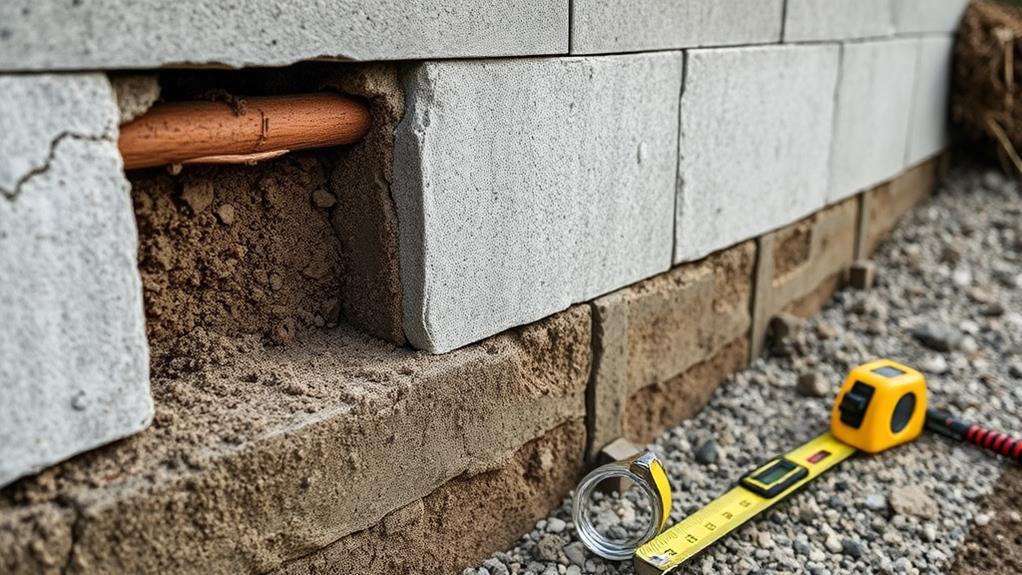Analyzing the structural integrity of retaining walls involves a multifaceted approach incorporating load distribution calculations, finite element modeling, and stability assessment methods. Engineers evaluate forces acting on the wall, including soil pressure and surcharge loads, to determine optimal dimensions and reinforcement requirements. Finite element analysis simulates stress distribution and potential failure modes, while stability assessments focus on resistance to overturning, sliding, and bearing capacity failure. Soil testing and classification play critical roles in informing design decisions and predicting long-term performance. This exhaustive analysis guarantees enhanced safety, reduced maintenance costs, and extended structural lifespan. A deeper understanding of these techniques reveals the complexities involved in creating robust and durable retaining wall structures.
Table of Contents
ToggleWalls Contractor Highlights
- Conduct load distribution calculations to analyze forces acting on the wall, including soil pressure and surcharge loads.
- Utilize finite element modeling to simulate stress distribution, deformation patterns, and potential failure modes.
- Perform stability assessment methods like limit equilibrium analysis to evaluate resistance to overturning, sliding, and bearing capacity failure.
- Carry out soil testing and classification to understand soil behavior and its impact on the retaining wall design.
- Calculate the factor of safety, aiming for at least 1.5 for static conditions and 1.1 for seismic conditions.
Structural Analysis Techniques

Structural analysis techniques form the foundation for ensuring the integrity and safety of retaining walls. Engineers employ a variety of methods, including load distribution calculations, finite element modeling, and stability assessment methods, to extensively evaluate the wall's performance under various conditions. These analyses are vital for preventing erosion and ensuring the wall effectively retains soil in place.
These advanced analytical tools enable designers to predict stress concentrations, deflections, and potential failure modes, thereby optimizing the wall's design for long-term durability and structural soundness.
Load Distribution Calculations
Engineers tasked with designing retaining walls must accurately calculate load distribution to guarantee structural stability and longevity. This critical process involves analyzing the various forces acting upon the wall, including soil pressure, hydrostatic pressure, and surcharge loads. By meticulously evaluating these factors, engineers can determine the ideal wall dimensions, reinforcement requirements, and foundation specifications necessary to withstand the anticipated stresses.
The load distribution calculation begins with a thorough site investigation, encompassing soil testing and geotechnical analysis. Engineers employ sophisticated software and mathematical models to simulate the wall's behavior under different loading scenarios. These simulations account for factors such as soil type, groundwater conditions, and potential seismic activity. The results inform the selection of appropriate construction materials and techniques, ensuring the wall's ability to resist sliding, overturning, and bearing capacity failure.
Furthermore, load distribution calculations consider the long-term performance of the retaining wall, factoring in potential changes in soil conditions, environmental impacts, and adjacent structures. This all-inclusive approach enables engineers to design retaining walls that not only meet immediate structural requirements but also maintain their integrity over an extended lifespan, providing lasting value and safety for the surrounding community.
Finite Element Modeling
Frequently employed in advanced structural analysis, Finite Element Modeling (FEM) has revolutionized the design process for retaining walls. This sophisticated computational method divides complex structures into smaller, more manageable elements, allowing engineers to simulate and analyze the behavior of retaining walls under various loading conditions with unprecedented accuracy.
By incorporating material properties, soil-structure interactions, and environmental factors, FEM provides an all-encompassing understanding of stress distribution, deformation patterns, and potential failure modes.
Engineers utilizing FEM can optimize retaining wall designs by iteratively adjusting parameters such as wall thickness, reinforcement placement, and foundation characteristics. This iterative process enables the development of more efficient and cost-effective solutions while ensuring compliance with safety standards.
In addition, FEM facilitates the exploration of innovative design concepts and materials, pushing the boundaries of conventional retaining wall construction. The ability to visualize stress concentrations and identify critical areas empowers engineers to implement targeted reinforcement strategies, enhancing the overall structural integrity.
As a result, FEM has become an indispensable tool for those seeking to create robust, reliable retaining walls capable of withstanding complex environmental challenges and safeguarding both property and lives.
Stability Assessment Methods
While Finite Element Modeling offers sophisticated analysis capabilities, stability assessment methods encompass a broad range of structural analysis techniques for evaluating retaining wall integrity. These methods include limit equilibrium analysis, slope stability analysis, and factor of safety calculations. Engineers employ these techniques to assess the wall's resistance to overturning, sliding, and bearing capacity failure modes.
Limit equilibrium analysis involves calculating the forces acting on the retaining wall and determining if they are in equilibrium. This method considers lateral earth pressures, surcharge loads, and the wall's self-weight to evaluate its stability against various failure mechanisms.
Slope stability analysis examines the potential for rotational or translational failure of the retained soil mass, often utilizing methods such as Bishop's simplified method or Janbu's method. Factor of safety calculations provide a quantitative measure of the wall's stability by comparing the resisting forces to the driving forces. Engineers typically aim for a factor of safety of at least 1.5 for static conditions and 1.1 for seismic conditions.
These assessment methods, when used in conjunction with Finite Element Modeling, provide an extensive evaluation of retaining wall structural integrity.
Benefits

The benefits of ensuring structural integrity in retaining walls extend far beyond mere aesthetic considerations. Proper structural analysis and design lead to enhanced safety and stability, considerably reducing the risk of wall failure and potential hazards to surrounding property and individuals.
Boulder retaining walls offer a long-lasting and cost-effective solution, with their sheer size providing a unique advantage as a building material. Additionally, a well-constructed retaining wall with high structural integrity requires less frequent maintenance, resulting in reduced long-term costs, while simultaneously improving property value and extending the overall lifespan of the structure.
Enhanced Safety and Stability
How do retaining walls contribute to enhanced safety and stability in construction projects? These essential structures provide a robust solution for managing soil pressure and preventing erosion, thereby profoundly improving the overall safety of landscapes and buildings. By effectively holding back soil and water, retaining walls create a stable foundation for construction, reducing the risk of landslides and soil displacement that could otherwise threaten nearby structures and individuals.
In addition to their primary function, retaining walls offer multifaceted benefits that enhance both safety and stability. They facilitate proper drainage systems, mitigating the risk of water accumulation and subsequent structural damage. This aspect is particularly indispensable in areas prone to heavy rainfall or flooding. Additionally, retaining walls enable the creation of level surfaces on sloped terrain, expanding usable space and improving accessibility. This not only increases property value but also guarantees safer navigation for pedestrians and vehicles.
Reduced Maintenance Costs
Investing in well-designed retaining walls greatly reduces long-term maintenance costs for construction projects. By prioritizing structural integrity during the initial design and construction phases, property owners and developers can considerably minimize the need for frequent repairs and replacements. This proactive approach not only guarantees the longevity of the retaining wall but also safeguards against potential safety hazards and costly remediation efforts.
A meticulously engineered retaining wall, constructed with high-quality materials and proper drainage systems, can withstand environmental stressors more effectively. This resilience translates to fewer instances of soil erosion, water damage, and structural deterioration over time. Consequently, the frequency of routine inspections and maintenance interventions decreases, leading to substantial cost savings throughout the wall's lifespan.
Additionally, the reduced need for repairs minimizes disruptions to surrounding landscapes and infrastructure, preserving the aesthetic appeal and functionality of the entire property. By incorporating advanced design techniques, such as geosynthetic reinforcement and pressure-relief systems, the wall's durability is further enhanced, extending its service life and maximizing the return on investment for property owners and stakeholders alike.
Improved Property Value
Robust retaining walls markedly enhance property value by providing both functional and aesthetic benefits to a site. These structures not only prevent soil erosion and create usable land on sloped terrain but also contribute to the overall visual appeal of the property. By effectively managing elevation changes, retaining walls can transform challenging landscapes into attractive, multi-level outdoor spaces that maximize land use and create a more inviting environment.
The installation of well-designed retaining walls often leads to increased curb appeal, which is a critical factor in property valuation. Real estate professionals and potential buyers recognize the added value of a property with professionally constructed retaining walls, as they indicate thoughtful landscaping and investment in long-term site stability. Additionally, the additional usable space created by retaining walls can be utilized for gardens, patios, or other outdoor living areas, effectively expanding the functional square footage of the property. This expansion of usable land often translates directly into higher property appraisals and can drastically boost resale value, making retaining walls a wise investment for homeowners and developers alike.
Extended Structural Lifespan
Through proper design and construction, retaining walls can achieve an extended structural lifespan, offering long-term benefits to property owners. This longevity guarantees that the investment made in the retaining wall continues to pay dividends for decades to come. By implementing advanced engineering techniques and utilizing high-quality materials, these structures can withstand the test of time, resisting environmental pressures and maintaining their integrity far beyond standard expectations.
The extended lifespan of a well-constructed retaining wall translates into reduced maintenance costs and fewer repairs over time. This durability provides property owners with peace of mind, knowing that their landscape will remain stable and aesthetically pleasing for years to come.
Additionally, the longevity of these structures contributes to sustainable land use practices, minimizing the need for replacements and reducing environmental impact. As communities endeavor for long-term solutions to erosion control and land management, retaining walls with extended lifespans become invaluable assets. They not only protect individual properties but also contribute to the overall stability and resilience of the surrounding area, fostering a sense of permanence and security for all residents.
Soil Testing and Classification

Soil testing and classification form the foundation of retaining wall design, ensuring structural integrity and longevity. A thorough soil composition analysis, coupled with advanced geotechnical investigation methods, provides vital data for engineers to make informed decisions. These analyses are typically categorized using established soil classification systems, which help standardize the assessment process and facilitate clear communication among project stakeholders.
| Soil Property | Testing Method | Significance |
|---|---|---|
| Particle Size | Sieve Analysis | Determines soil texture and drainage characteristics |
| Shear Strength | Direct Shear Test | Assesses soil's ability to resist lateral forces |
| Plasticity | Atterberg Limits | Indicates soil behavior under varying moisture conditions |
Soil Composition Analysis
For successful retaining wall design and construction, a thorough soil composition analysis is indispensable. This vital process involves examining the various components that make up the soil, including sand, silt, clay, and organic matter. By determining the proportions of these elements, engineers can accurately assess the soil's properties and behavior under different conditions.
The analysis typically begins with collecting representative soil samples from the proposed construction site. These samples undergo a series of laboratory tests to determine particle size distribution, plasticity, and organic content. Advanced techniques such as X-ray diffraction and scanning electron microscopy may be employed to identify specific clay minerals present in the soil.
Understanding the soil's composition allows engineers to predict its strength, compressibility, and drainage characteristics, which are imperative factors in retaining wall design. Additionally, the analysis helps identify potential issues such as expansive clays or highly organic soils that may require special consideration or treatment. By conducting an extensive soil composition analysis, engineers can ensure that the retaining wall is designed to withstand the specific soil conditions at the site, ultimately leading to a more stable and durable structure.
Geotechnical Investigation Methods
Geotechnical investigation methods form the backbone of soil testing and classification in retaining wall projects. These extensive procedures are essential for understanding the subsurface conditions that will influence the design and construction of the retaining structure. Engineers and geologists employ a variety of techniques to gather pivotal data about soil properties, groundwater conditions, and underlying rock formations.
One of the primary methods utilized is soil boring, which involves drilling deep into the ground to extract soil samples for laboratory analysis. These samples are subjected to various tests, including grain size distribution, Atterberg limits, and shear strength assessments.
In situ testing techniques, such as cone penetration tests (CPT) and standard penetration tests (SPT), provide valuable information about soil consistency and bearing capacity. Geophysical methods, including seismic refraction and electrical resistivity surveys, offer non-invasive means of mapping subsurface conditions over larger areas.
Additionally, groundwater monitoring wells are often installed to assess water table fluctuations and pore pressure changes. The data collected through these geotechnical investigation methods is meticulously analyzed to develop a thorough understanding of the site's soil profile, enabling engineers to design retaining walls that can withstand the anticipated loads and environmental conditions.
Soil Classification Systems
Invariably, the foundation of effective retaining wall design rests upon accurate soil classification. Engineers and geotechnical specialists rely on standardized soil classification systems to categorize and comprehend the properties of different soil types.
The two primary systems utilized in the industry are the Unified Soil Classification System (USCS) and the American Association of State Highway and Transportation Officials (AASHTO) system.
The USCS, widely adopted in geotechnical engineering, classifies soils based on particle size distribution and plasticity characteristics. It employs a two-letter designation system, with the first letter indicating the primary soil type (G for gravel, S for sand, M for silt, C for clay) and the second letter providing additional information about gradation or plasticity.
The AASHTO system, predominantly used in road construction, categorizes soils into seven main groups (A-1 through A-7) based on grain size distribution, liquid limit, and plasticity index.
Both systems provide essential insights into soil behavior, allowing engineers to predict potential issues such as settlement, drainage, and stability. By accurately classifying soils, professionals can make informed decisions regarding retaining wall design, ensuring long-term structural integrity and ideal performance.
Walls Contractor FAQ
How Often Should Retaining Walls Be Inspected for Structural Integrity?
Retaining walls should be inspected annually for structural integrity, with additional checks after severe weather events or earthquakes. Regular inspections guarantee early detection of issues, maintaining safety and longevity for our community's infrastructure investments.
What Are the Signs of an Impending Retaining Wall Failure?
Signs of impending retaining wall failure include visible cracks, bulging or leaning, soil erosion, water seepage, and separation from adjoining structures. Regular inspections by our community's experts can help identify these issues early, ensuring our collective safety.
Can Landscaping Affect the Structural Integrity of a Retaining Wall?
Absolutely, landscaping can enormously impact a retaining wall's structural integrity. Improper plant selection, excessive irrigation, or root intrusion can compromise drainage, increase soil pressure, and weaken the wall's foundation. Careful planning is essential for maintaining wall stability and longevity.
Are There Specific Building Codes for Retaining Wall Construction?
Yes, there are specific building codes for retaining wall construction. These codes vary by location but typically address factors like wall height, material requirements, drainage systems, and structural design. Abiding by these codes guarantees safety and community compliance.
How Do Extreme Weather Conditions Impact Retaining Wall Stability Over Time?
Extreme weather conditions can considerably affect retaining wall stability over time. Frequent freeze-thaw cycles, heavy rainfall, and temperature fluctuations can lead to soil expansion, erosion, and material degradation, potentially compromising the wall's structural integrity and longevity.







